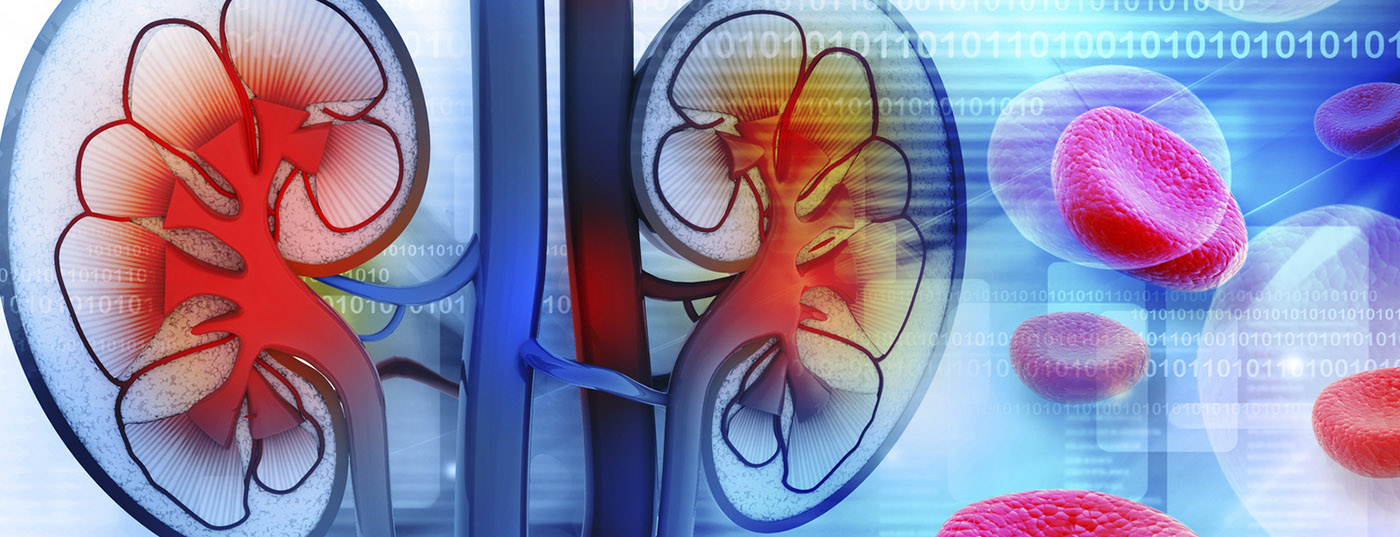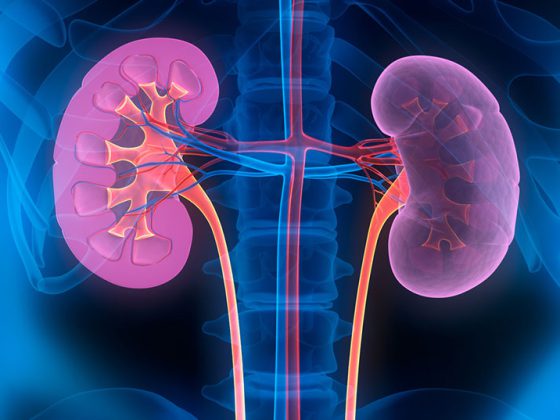Nephropathy as a late complication of diabetes is a common cause of renal failure requiring dialysis. In the CREDENCE trial, SGLT-2 inhibitors slowed the progression of renal dysfunction in diabetic patients. This effect is very significant, as it is also associated with a lower cardiovascular risk and a reduction in mortality.
Chronic kidney disease (CKD) is a serious complication of diabetes that is associated with an increased risk of end-stage renal disease (ESRD) and reduced life expectancy. According to international data, about 30-50% of cases of CKD are caused by diabetes and about 50% of all diabetics develop chronic kidney disease despite treatment [1–3]. Especially in diabetic patients with hypertension, kidney damage may occur in the long run.
CKD is a cardiovascular risk factor
Chronic kidney disease increases the likelihood of a cardiovascular event and the risk of mortality. More than half of patients with progressive diabetic kidney disease die from cardiovascular complications before dialysis initiation [4]. Diagnostic classification forms the basis for therapeutic measures aimed at delaying the progression of kidney disease and is based on the following three criteria (abbreviated “CGA”): Cause (“Cause”); glomerular filtration rate (GFR) G1-G5; albuminuria A1-A3. Kidney disease is considered chronic if the change in kidney structure and function persists for more than three months. Gluconeogenesis and glucose reabsorption reduce with increasing renal functional impairment. Clearance of exogenously delivered insulin decreases and reaches a critical limit in clinical terms below an estimated glomerular filtration rate (eGFR) of about 20 ml/min/1.73 m2, accompanied by an increased risk of hypoglycemia [5]. In diabetic patients with CKD, HbA1c target values should be individualized because advantages and disadvantages vary by patient [6]. Recommended target range for non-dialysis dependent renal patients is <6.5% to <8%. Well-controlled blood glucose levels have a positive effect on renal function.
SGLT-2 inhibition as an important therapeutic component
In recent years, it has been repeatedly demonstrated that SGLT-2 inhibitors not only have positive effects on glucose metabolism, but also have cardio- and nephroprotective effects. In the phase III CREDENCE study, canagliflozin led to a 30% reduction in the primary renal endpoint* compared to placebo in patients with diabetic nephropathy as an add-on to standard therapy over a 2.6-year period (n=4401). [8,23]. In the CREDENCE trial, the stabilizing effect of SGLT-2 inhibitor on eGFR in CKD was shown to be independent of a reduction in HbA1c[8]. The hypothesis that mechanisms of action of nephroprotection and cardiovascular protection need not be associated with a direct reduction in HbA1c is further supported by subgroup analyses of cardiovascular outcome trials with SGLT-2 inhibitors [9–11] and by the DAPA-HF (Heart Failure with and without Diabetes Mellitus) trial [12]. The DAPA-CKD study [13], which was terminated prematurely due to good results, and the EMPA-KIDNEY study [14], which is currently ongoing, are also addressing this aspect, among others.
* eGFR=30-90 ml/min/1.73m2; albuminuria 300-5000 mg/g.
Blood pressure control, renin-angiotensin system blockade, and SGLT-2 inhibition are three critical factors in delaying progression of CKD. SGLT-2 inhibitors result in increased urinary excretion of glucose and, unlike other antidiabetic agents, are independent of insulin. The effects are due to the inhibition of sodium-glucose co-transporter 2 (SGLT-2) at the kidney, which is responsible for the reabsorption of glucose from the urine into the bloodstream. Processes triggered by activation of the tubuloglomerular feedback mechanism in the kidney reduce albuminuria by 30% and have an organ-protective effect [15]. This results in delayed progression of kidney disease with a smaller drop in GFR over time. This is associated on the one hand with a lower proportion of patients requiring dialysis and on the other hand with a reduction in hospitalization due to cardiovascular events [12,16–18].
Note glomerular filtration rate
At an eGFR 30-45 ml/min/1.73m2, of the modern antidiabetic agents, GLP-1-RA (glucagon-like peptide-1 receptor
agonist) can be used. If eGFR <30 ml/min/1.73m2, a DPP-4 inhibitor or GLP-1 RA can be used, with additional basal insulin if needed . SGLT-2 inhibitors are not recommended at such low eGFR values [19]. GLP-1 RA have cardioprotective effects, and nephroprotective effects are mild. When combined with sulfonylureas or insulin in concomitant therapy, the risk of hypoglycemia is increased in contrast to GLP-1 RA monotherapy. In diabetic patients with hypertension and albuminuria, an angiotensin-converting enzyme (ACE) inhibitor or angiotensin II receptor blocker (ARB) is recommended for the purpose of inhibiting the renin-angiotensin-aldosterone system (RAAS). This may be considered in cases of albuminuria and normotension. A combination of ACE inhibitors and ARBs is not recommended because of the risks of side effects. As several studies show, complementary lifestyle modification (especially smoking cessation, diet, physical activity) can also have a beneficial effect on the incidence of microvascular and macrovascular complications and on mortality [20,21].
Summary
- Approximately 30-50% of chronic kidney disease (CKD) cases are secondary to diabetes [1–3].
- SGLT-2 inhibitors (SGLT-2i) not only have beneficial effects on glucose metabolism, but also have cardio- and nephroprotective effects. This has been empirically proven several times [9–11].
- In the CREDENCE trial, therapy with an SGLT-2i resulted in stabilization of CKD progression independent of a reduction in HbA1c [8]. SGLT-2i are recommended for eGFR ≥30 ml/min/1.73m2 [24].
Literature:
- Webster AC, et al: Chronic Kidney Disease. Lancet 2017; 389: 1238-1523.
- Liyanage T, et al: Worldwide access to treatment for end-stage kidney disease: a systematic review. Lancet 2015; 385: 1975-1982.
- IDF: Diabetes Atlas, www.diabetesatlas.org
- Wanner C, Lopau K: Diabetic nephropathy: the new role of the kidney. Dtsch Arztebl 2020; 117(20): [4]; DOI: 10.3238/PersDia.2020.05.15.01.
- Makin V, Lansang MC: Diabetes management: Beyond hemoglobin A1c. Cleve Clin J Med 2019; 86: 595-560.
- Kidney Deseases Improving Global Outcomes (KDIGO): KDIGO Clinical Practice Guideline on Diabetes Management in Chronic Kidney Disease. Public Review Draft December 2019. https://kdigo.org
- Seeger H: Cardio-renal complications in type 2 diabetes mellitus. Mundipharma Symposium. Slide presentation, PD Harald Seeger, MD. FOMF Zurich, Dec. 3, 2019.
- Perkovic V, et al: Canagliflozin and Renal Outcomes in Type 2 Diabetes and Nephropathy. NEJM 2019; 380(24): 2295-2306.
- Wanner C, et al: Empagliflozin and Progression of Kidney Disease in Type 2 Diabetes. NEJM 2016; 375: 323-334.
- Neal B, et al: Canagliflozin and Cardiovascular and Renal Events in Type 2 Diabetes. NEJM 2017; 377(7): 644-657.
- Wiviott SD, et al: Dapagliflozin and Cardiovascular Outcomes in Type 2 Diabetes. NEJM 2019; 380(4): 347-357.
- McMurray JJV, et al: Dapagliflozin in Patients with Heart Failure and Reduced Ejection Fraction. N Engl J Med 2019; 381: 1995-2008.
- AstraZeneca: Farxiga Phase III DAPA-CKD trial, press release, March 30, 2020. www.astrazeneca.com
- Herrington WG, et al: The potential for improving cardio-renal outcomes by sodium-glucose co-transporter-2 inhibition in people with chronic kidney disease: a rationale for the EMPA-KIDNEY study. Clin Kidney J 2018; 11: 749-761.
- Vallon V, Thomson SC: Targeting renal glucose reabsorption to treat hyperglycaemia: the pleiotropic effects of SGLT2 inhibition. Diabetologia 2017; 60: 215-225.
- Shivakumar O, et al: Sodium-glucose cotransporter 2 inhibitor effects on cardiovascular outcomes in chronic kidney disease. Nephrol Dial Transplant 2020; 35: i43-47.
- Neuen Bl, et al: Sodium glucose cotransporter 2 inhibition: which patient with chronic kidney disease should be treated in the future? Nephrol Dial Transplant 2020; 35: i48-55.
- Zinman B, et al: Empagliflozin, Cardiovascular Outcomes, and Mortality in Type 2 Diabetes. NEJM 2015; 373(22): 2117-2128.
- Schories M: The management of major diabetic complications. Dr. Marcus Schories, FOMF, Jan. 29, 2020, Basel.
- Gaede P, et al: Multifactorial intervention and cardiovascular disease in patients with type 2 diabetes. NEJM 2003; 348: 383-393.
- Gaede P, et al: Years of life gained by multifactorial intervention in patients with type 2 diabetes mellitus and microalbuminuria: 21 years follow-up on the Steno-2 randomised trial. Diab 2016; 59: 2298-2230.
- Pálsson R, Patel UD : Cardiovascular Complications of Diabetic Kidney Disease. Advances in Chronic Kidney Disease 2014; 21(3): 273-280.
- Jardine MJ, et al: The Canagliflozin and Renal Endpoints in Diabetes with Established Nephropathy Clinical Evaluation (CREDENCE) Study Rationale, Design, and Baseline Characteristics. Am J Nephrol 2017; 46(6): 462-472.
- Lehmann R: Diabetes mellitus type 2. slide presentation, Prof. Roger Lehman, MD, FOMF Zurich, Dec 04, 2019.
GP PRACTICE 2020; 15(8): 40-41












